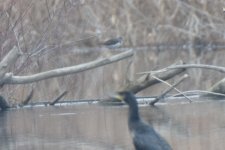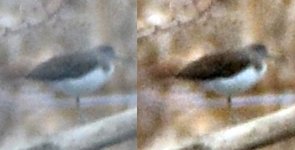-
Welcome to BirdForum, the internet's largest birding community with thousands of members from all over the world. The forums are dedicated to wild birds, birding, binoculars and equipment and all that goes with it.
Please register for an account to take part in the discussions in the forum, post your pictures in the gallery and more.
You are using an out of date browser. It may not display this or other websites correctly.
You should upgrade or use an alternative browser.
You should upgrade or use an alternative browser.
Wader (Central Spain) (1 Viewer)
- Thread starter SLopezM
- Start date
More options
Who Replied?Valéry Schollaert
Respect animals, don't eat or wear their body or s
Green Sandpiper for me.
For me too
Valéry Schollaert
Respect animals, don't eat or wear their body or s
And couldn't it be a Common sandpiper?
Legs too long, no visible tail (always visible in Common) and breast pattern is wrong for Common.
Valéry Schollaert
Respect animals, don't eat or wear their body or s
common sand for me - breast pattern looks ok - too pale for green
Pale or dark, without a comparison, cannot be used. Depends of lighting, exposition of the photo and post-treatment (even if automatic).
You can use a feature than doesn't need comparison. The tail of a Common Sandpiper goes further beyond the wing tip. No Tringa is like that. Although the photo is poor, clearly there is no tail beyond the tail tip, visible, so not a Common Sandpiper.
The white of the breast of Common Sandpiper would goes further up along the wing.
johnallcock
Well-known member
Another vote for Common Sandpiper from me. The breast pattern looks wrong for Green, with the dark extending forward from the sides of the wing and the centre of the breast pale - Green should be cut straight across the breast. The hunched posture looks better for Common to me, and the plumage tones also look better. Also, in my experience, Green very rarely perches on branches (away from the breeding grounds, I haven't seen them when breeding), but this is not at all unusual for Common Sandpiper.
Given the quality of the image I'd be reluctant to say for sure whether or not the tail would be visible in the field. I think the bird is not perched on the large branch, so leg length is also difficult to judge.
Given the quality of the image I'd be reluctant to say for sure whether or not the tail would be visible in the field. I think the bird is not perched on the large branch, so leg length is also difficult to judge.

Another vote for Common Sandpiper from me. The breast pattern looks wrong for Green, with the dark extending forward from the sides of the wing and the centre of the breast pale - Green should be cut straight across the breast. The hunched posture looks better for Common to me, and the plumage tones also look better. Also, in my experience, Green very rarely perches on branches (away from the breeding grounds, I haven't seen them when breeding), but this is not at all unusual for Common Sandpiper.
Given the quality of the image I'd be reluctant to say for sure whether or not the tail would be visible in the field. I think the bird is not perched on the large branch, so leg length is also difficult to judge.
I agree with this assessment.
Valéry Schollaert
Respect animals, don't eat or wear their body or s
I should add Common sandpiper is easy to find here, while I have never seen a Green one. Anyway, according to books Green sandpiper can be found in the area during winter, that's why I had doubts with this picture.
They (Green Sand.) are now passing massively through Europe.
Valéry Schollaert
Respect animals, don't eat or wear their body or s
Another vote for Common Sandpiper from me. The breast pattern looks wrong for Green, with the dark extending forward from the sides of the wing and the centre of the breast pale - Green should be cut straight across the breast. The hunched posture looks better for Common to me, and the plumage tones also look better. Also, in my experience, Green very rarely perches on branches (away from the breeding grounds, I haven't seen them when breeding), but this is not at all unusual for Common Sandpiper.
Given the quality of the image I'd be reluctant to say for sure whether or not the tail would be visible in the field. I think the bird is not perched on the large branch, so leg length is also difficult to judge.
I'm sorry, you should have another look.
You say "with the dark extending forward from the sides of the wing and the centre of the breast pale - Green should be cut straight across the breast. "
It is exactly like this one, the first I found on Google Image.
https://upload.wikimedia.org/wikipe.../1200px-Green_sandpiper_(Tringa_ochropus).jpg
"Also, in my experience, Green very rarely perches on branches"
May be in UK, but generally speaking, it does more than Common Sandpiper.
"Given the quality of the image I'd be reluctant to say for sure whether or not the tail would be visible in the field."
Well, we clearly see the legs, no reason that tail wouldn't be seen.
It is a perfect Green Sandpiper, and you prefer to imagine the legs, clearly visible, cannot be judged, and the tail miraculously concealed to lead to a Common Sandpiper... very strange.
100% sure Green Sandpiper for me.
CARERY
Well-known member
I'm sorry, you should have another look.
You say "with the dark extending forward from the sides of the wing and the centre of the breast pale - Green should be cut straight across the breast. "
It is exactly like this one, the first I found on Google Image.
https://upload.wikimedia.org/wikipe.../1200px-Green_sandpiper_(Tringa_ochropus).jpg
"Also, in my experience, Green very rarely perches on branches"
May be in UK, but generally speaking, it does more than Common Sandpiper.
"Given the quality of the image I'd be reluctant to say for sure whether or not the tail would be visible in the field."
Well, we clearly see the legs, no reason that tail wouldn't be seen.
It is a perfect Green Sandpiper, and you prefer to imagine the legs, clearly visible, cannot be judged, and the tail miraculously concealed to lead to a Common Sandpiper... very strange.
100% sure Green Sandpiper for me.
Where is the need for this quite agressive undertone? It is one thing to be convinced by your ID, which I still support BTW, but to ask others in this manner to look again, I don't know... I wouldn't be encouraged to continue in this thread!
Back to the topic. I appreciate it is a very blurry image. The recent - also rather heated - discussion about the IDability of those kind of pour photos comes to mind. I based my ID as Green mainly at the strong contrast from dark upperside to white belly and the seemingly too long legs and bill. Don't know if there is or is not a protruding tail, wouldn't dare to be sure. But the white at the throat isn't a problem for Green. I found another photo showing this quite well:
http://www.africanbirdclub.org/afbid/search/birddetails/species/579/30962
As for the perching on branches. I have seen Green Sandpipers do that (also during migration when resting). Why shouldn't they as they even breed in old nests of Thrushes :t:?
For me it still looks like a Green Sandpiper but who knows with this low quality photo... More (blurry
Last edited:
Mark Lew1s
My real name is Mark Lewis
Another for common sand.
Valéry Schollaert
Respect animals, don't eat or wear their body or s
Where is the need for this quite agressive undertone? It is one thing to be convinced by your ID, which I still support BTW, but to ask others in this manner to look again, I don't know... I wouldn't be encouraged to continue in this thread!
Back to the topic. I appreciate it is a very blurry image. The recent - also rather heated - discussion about the IDability of those kind of pour photos comes to mind. I based my ID as Green mainly at the strong contrast from dark upperside to white belly and the seemingly too long legs and bill. Don't know if there is or is not a protruding tail, wouldn't dare to be sure. But the white at the throat isn't a problem for Green. I found another photo showing this quite well:
http://www.africanbirdclub.org/afbid/search/birddetails/species/579/30962
As for the perching on branches. I have seen Green Sandpipers do that (also during migration when resting). Why shouldn't they as they even breed in old nests of Thrushes :t:?
For me it still looks like a Green Sandpiper but who knows with this low quality photo... More (blurry) photos could help.
If I explain that, I will look agressive for real. 3
CARERY
Well-known member
Another for common sand.
So this is democracy then, overruled :-C :-O
lou salomon
the birdonist
A common sand is a common sand whether we've got democracy or not in our ID rounds.
RichieTwitchy
YNWA
Similar threads
- Replies
- 2
- Views
- 547
Users who are viewing this thread
Total: 2 (members: 0, guests: 2)





